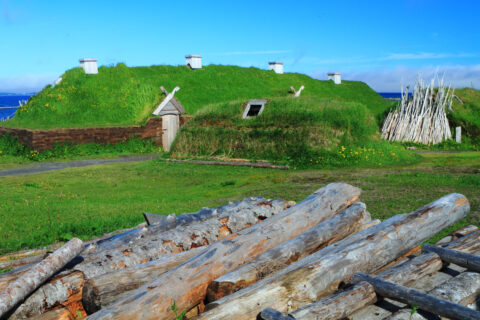Eirík Þorvaldsson’s son name was Leif. He was, according to the Saga of Erik the Red, the first European to discover America. A statue of Leif stands in front of the entrance to the Hallgrímskirkja church in Reykjavik.
Eiriksstadir – Viking Longhouse is the former home of Nordic bandit Eirík Þorvaldsson, also known as Erik the Red (or Red).
Taste of Viking life
Today the house is a “living museum” where modern descendants of the Vikings demonstrate the lifestyle of 1,000 years ago, sharing their crafts and knowledge.
Eirík Þorvaldsson’s son name was Leif. He was, according to the Saga of Erik the Red, the first European to discover America. A statue of Leif stands in front of the entrance to the Hallgrímskirkja church in Reykjavik.
When you visit Eiriksstadir, you’ll see how the people of Iceland lived in the 9th and 10th centuries, try out the weapons of the time and… dress up as a Viking. You’ll also learn that up to 20 people could live in such a house, that men had no access (or key) to the pantry and that girls slept in the attic bedroom, because there they were protected from men….
Although many people believe that Viking helmets had horns, archaeological findings around Eiriksstadir (as well as many others) indicate that this was not the case at all. Instead, the Vikings used the horns for drinking and made various tools from them.
Eiriksstadir – tips and practical information
- Eiríksstaðir is open daily from 10 a.m. to 3 p.m.
- Tickets to the museum can be purchased at the ticket office near the parking lot. A ticket for an adult costs 1,250 ISK (£40). Children enter the museum for free. Guided tours and storytelling take place every half hour.
- There is a parking lot, a museum store and a cafe next to the museum.
- There is usually a food truck in front of the building, called Þjóðhildarpotturinn or Eric the Red’s Kitchen. There you can buy traditional Icelandic dishes, both contemporary and Viking-style.
- On the last weekend in August, Eiriksstadir hosts a Viking festival. This is an initiative of the new owners, who took over the property in 2019.
How to get to Eiriksstadir
Eiriksstadir is located on Road 586, east of Lake Haukadalsvatn.
It is a place on the border of Cape Snaefellsnes and the West Fjords, about 12 km southeast of the town of Budardalur (Búðardalur).
Other places where you can feel like a Viking
The origins of settlement in Iceland are inextricably linked to the Vikings. Many places try to recall and bring those times closer, sometimes even in a very literal way. Here are some examples:
- Ingólfsskáli Viking Restaurant
True to its name, this place is primarily a restaurant, but it showcases traditional dishes and everyday objects modeled on those from the 11th-12th centuries. It also allows you to try some of the Viking pastimes yourself, such as throwing an axe at a target…. It lies in southern Iceland, between the towns of Hveragerdi and Selfoss, on Road 374 (a side road from Road 1), about 40 km east of Reykjavik. - The Settlement Exhibition (isl. Landnámssýningin, English: The Settlement Exhibition)
is the place with the most scientific and cross-sectional approach to the Vikings. The museum is located in the center of Reykjavik (16 Adalstraeti Street) and takes a closer look at the lives of Iceland’s first settlers (that is, the de facto Vikings). - The Saga Museum (Saga Museum)
as the name suggests focuses on recreating and depicting the stories, tales and legends from traditional Icelandic sagas. It also depicts key moments in Icelandic history that determined the fate of the nation. It’s actually more of a popular science exhibition than a museum, as it has and exhibits virtually no historical objects. It is located in Reykjavik, in the harbor district, at 2 Grandagardur Street. - Þjóðveldisbærinn Stöng
This is a similar, though noticeably larger, site than Eiriksstadir. Based on a historic house discovered nearby, an entire farmhouse from the end of the Nordic era has been reconstructed here. The original buildings were buried in volcanic ash in 1104 after the eruption of the Hekla volcano. The site lies in southern Iceland, east of Fludir, on Road 32.
I write more about these sites in a separate article: What museums are worth seeing in Reykjavik.
